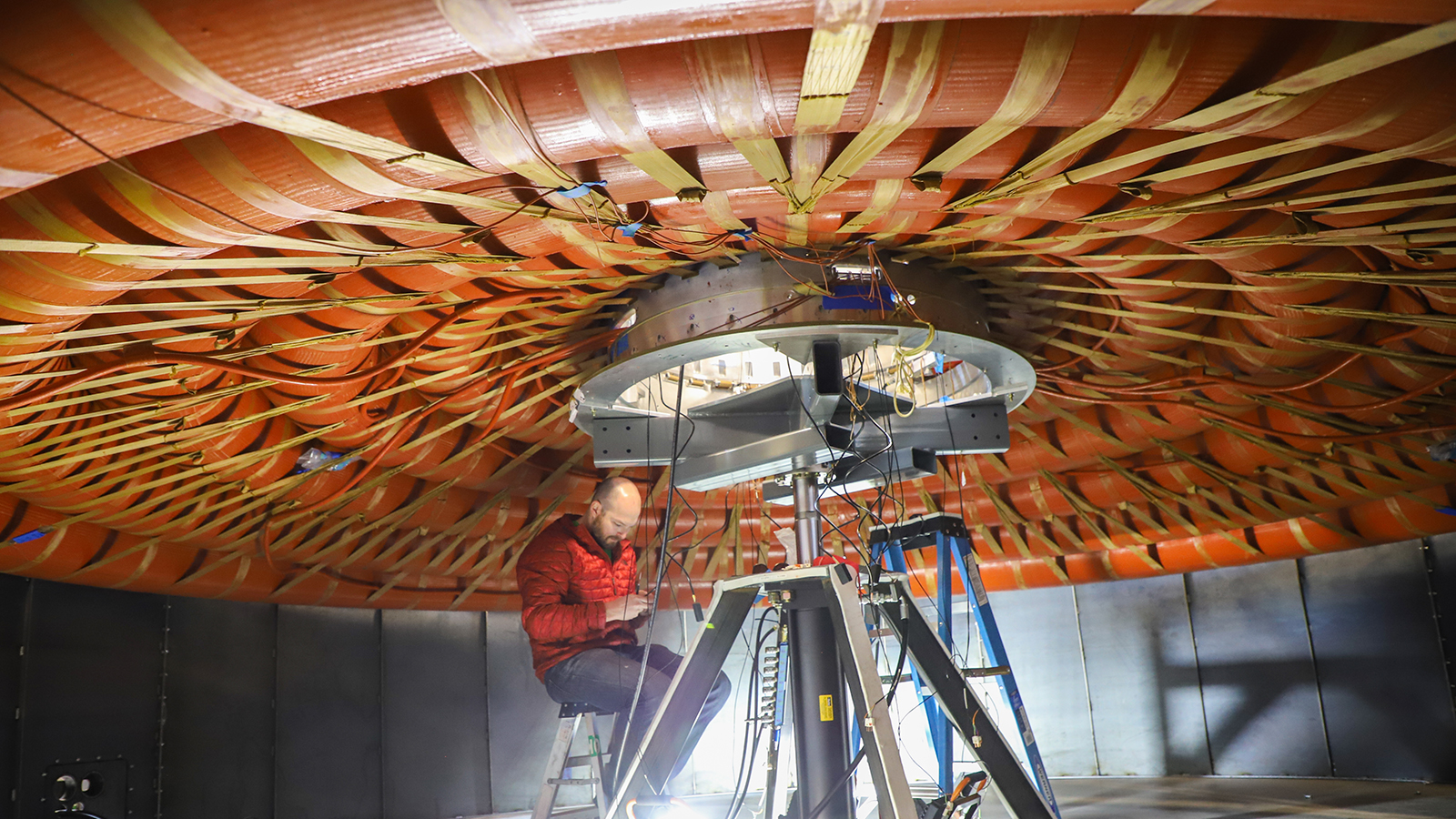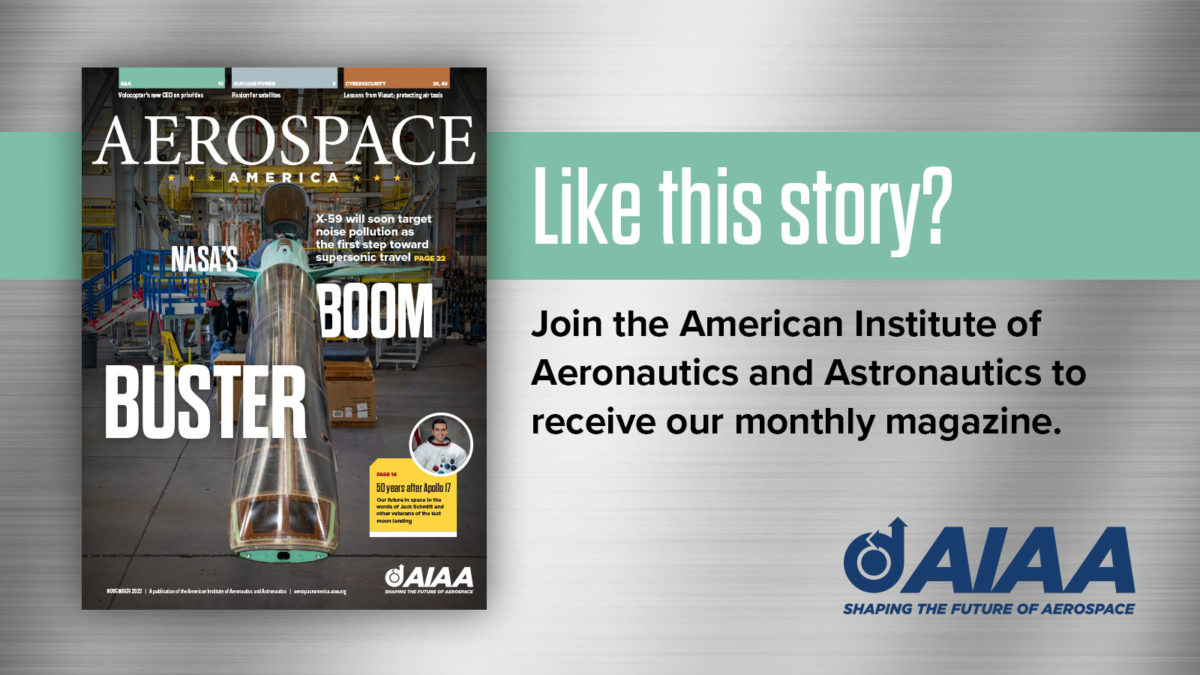Stay Up to Date
Submit your email address to receive the latest industry and Aerospace America news.
Updates
Nov. 11: NASA’s experimental inflatable heat shield was fished out of the Pacific Ocean Thursday by technicians, after the unit inflated and separated from the upper stage of a United Launch Alliance Atlas V rocket and reentered the atmosphere as planned during the launch of NOAA’s Joint Polar Satellite System-2 weather satellite. The shield carried a data module that was recovered. “The LOFTID team will analyze the recorded data and inspect the heat shield to assess how the technology performed,” NASA said in a prepared statement. View the full launch or a clip of the deployment.
Oct. 26 original story
AIAA ASCEND, Las Vegas — After five years of development and subscale testing, NASA’s handstitched Low-Earth Orbit Flight Test of an Inflatable Decelerator is ready to be sent to space in November.
Plans call for launching LOFTID into orbit as a rideshare payload on a United Launch Alliance Atlas V together with a NOAA weather satellite. LOFTID aims to prove an entirely new method for delivering large spacecraft to the surface of other planets, or in ULA’s case, rocket engines back home for reuse.
If all goes as NASA and ULA hope, nitrogen from tanks in the rocket’s upper stage will inflate LOFTID into its hallmark dish shape, and after completing an orbit, it will reenter the atmosphere nose first for a splashdown east of Hawaii, where it will be recovered.
The technology could be particularly relevant to Mars scientists because fuller exploration there would require landing large equipment, potentially habitats and vehicles, that need far larger aeroshells than can be launched today.
“We’re kind of bumping up against the limit of Viking heritage technology with a rigid aeroshell that fits inside the launch vehicle shroud with the supersonic parachute needed for the descent,” explained NASA’s Michelle Munk in a LOFTID briefing here. She was referring to the aeroshells that have protected every NASA spacecraft sent to the surface of Mars since the Viking 1 and 2 landings in 1976.
With the inflatable technology, sometimes called HIAD for hypersonic inflatable aerodynamic decelerator, the vehicle shroud would be less of a constraint. Once inflated, LOFTID will have a 6-meter diameter, but that’s just a start. NASA wants the ability to land 20 metric tons on Mars, which is about the weight of an average semi-truck on U.S. highways. For that, NASA estimates it will need a 16-meter-diameter version. ULA will need something in between those diameters to land the two BE-4 engines of Vulcan Centaur’s main stage for reuse, the company’s NASA partners said.
Munk said the upcoming Mars Sample Return launch, targeted for 2028, will carry the most payload that can fit in the rigid heat shield. Aboard will be a lander, two Mars helicopters, a sample return container and an ascent rocket to blast the container into space.
If successful, the LOFTID test also could pave the way for landing on Saturn’s moon Titan, where the atmosphere is 50% denser than Earth’s, or on Venus, which has an atmosphere 100 times as dense as Earth’s, Munk said.
A scale model showing the inflated configuration of LOFTID stood behind Munk on stage during the briefing. Concentric rings of inflated textiles surrounded the center of the shield, forming a dish.
The LOFTID experiment will ride with NOAA’s Joint Polar Satellite System 2, a polar-orbiting weather satellite built by Northrop Grumman. After the main payload is released, LOFTID will be inflated with nitrogen from tanks on the upper stage, and then separate to stage at about 650 kilometers above the Pacific Ocean.
LOFTID will transmit performance data to NASA, but the agency hopes to recover it east of Hawaii to evaluate its condition and retrieve more data.
The mission is a joint effort with ULA, which originally proposed the project years ago, Munk said. For the test, ULA has provided tanks of compressed nitrogen to inflate the shield, but Munk said other means of generating gas, perhaps hydrogen, would need to be devised for future heat shields.
LOFTID could also open up more areas of Mars for landing.
“To date, we’ve gone to low spots on Mars because even that little bit of extra atmosphere that you can fly through helps you slow down and land safely,” she said. “So some scientists are interested in going to the southern highlands of Mars, and a larger decelerator of this nature would allow us to do that by decelerating at a higher altitude.”
About paul brinkmann
Paul covers advanced air mobility, space launches and more for our website and the quarterly magazine. Paul joined us in 2022 and is based near Kennedy Space Center in Florida. He previously covered aerospace for United Press International and the Orlando Sentinel.
Related Posts
Stay Up to Date
Submit your email address to receive the latest industry and Aerospace America news.





